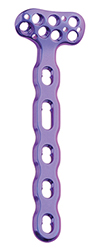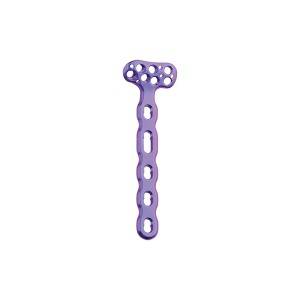Features:
1. Manufactured in titanium and advanced processing technology;
2. Low profile design helps reduce soft tissue irritation;
3. Surface anodized;
4. Anatomical shape design;
5. Combi-hole can be choosing both locking screw and cortex screw;
Indication:
An implant of volar locking plate is suitable for distal volar radius, any injuries which cause growth arrest to the distal radius.
Used for Φ3.0 orthopedic locking screw, Φ3.0 orthopedic cortex screw, matched with 3.0 series surgical instrument set.

|
Order code |
Specification |
|
|
10.14.20.03104000 |
Left 3 Holes |
57mm |
|
10.14.20.03204000 |
Right 3 Holes |
57mm |
|
10.14.20.04104000 |
Left 4 Holes |
69mm |
|
10.14.20.04204000 |
Right 4 Holes |
69mm |
|
*10.14.20.05104000 |
Left 5 Holes |
81mm |
|
10.14.20.05204000 |
Right 5 Holes |
81mm |
|
10.14.20.06104000 |
Left 6 Holes |
93mm |
|
10.14.20.06204000 |
Right 6 Holes |
93mm |
Volar locking plates for the treatment of distal radius fractures with or without bone augmentation do not affect the radiographic outcomes. In comminuted fractures, additional bone augmentation is unnecessary if intraoperative anatomical reduction and fixation are performed when possible.
The use of volar locking plates for surgical fixation of distal radius fractures has become popular. However, several complications associated with this type of surgery have been reported, including tendon rupture. Rupture of the flexor pollicis longus tendon and the extensor pollicis longus tendon associated with repair of distal radius fractures with such a plate was first reported in 19981 and 2000,2 respectively. The reported incidence of flexor pollicis longus tendon rupture associated with the use of a volar locking plate for distal radius fracture has ranged from 0.3% to 12%.3,4 To minimize the occurrence of flexor pollicis longus tendon rupture after volar plate fixation of distal radius fractures, the authors paid attention to placement of the plate. In a series of patients with distal radius fractures, the authors investigated annual trends in the number of complications in relation to the treatment measures. The current study investigated the incidence of complications after surgery for distal radial fractures with a volar locking plate.
There was a complication rate of 7% in the current series of patients with distal radius fractures treated with surgical fixation with a volar locking plate. Complications included carpal tunnel syndrome, peripheral nerve palsy, trigger digit, and tendon rupture. The watershed line is a useful surgical landmark for positioning a volar locking plate. No cases of flexor pollicis longus tendon rupture occurred among the 694 patients because careful attention was paid to the relationship between the implant and the tendon.
Our results support that volar fixed-angle locking plates are an effective treatment for unstable extra-articular distal radius fractures, allowing early postoperative rehabilitation to safely be initiated.







